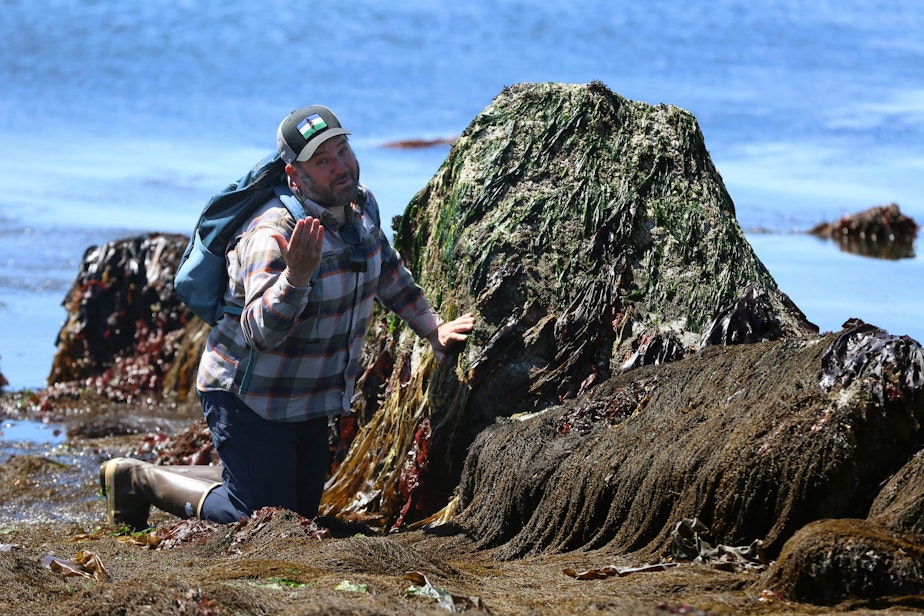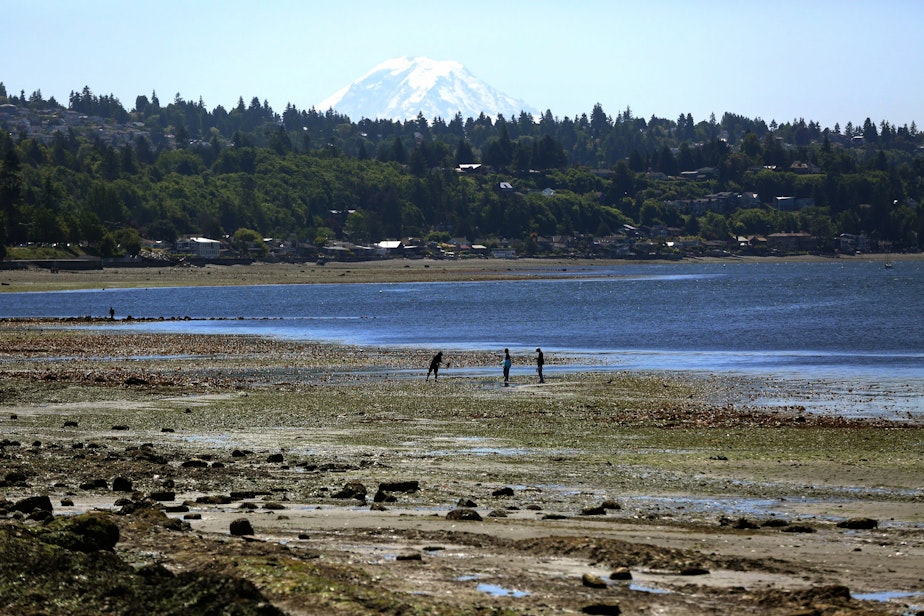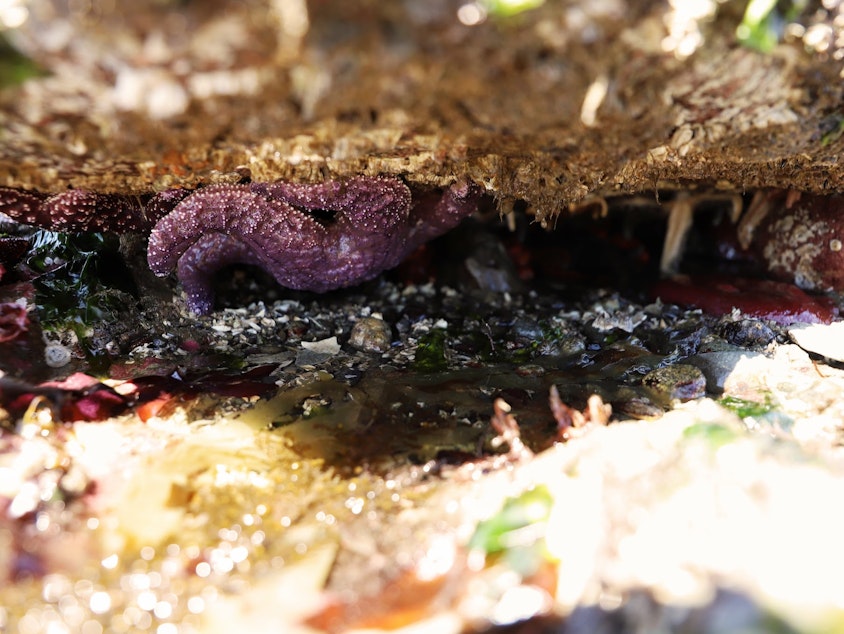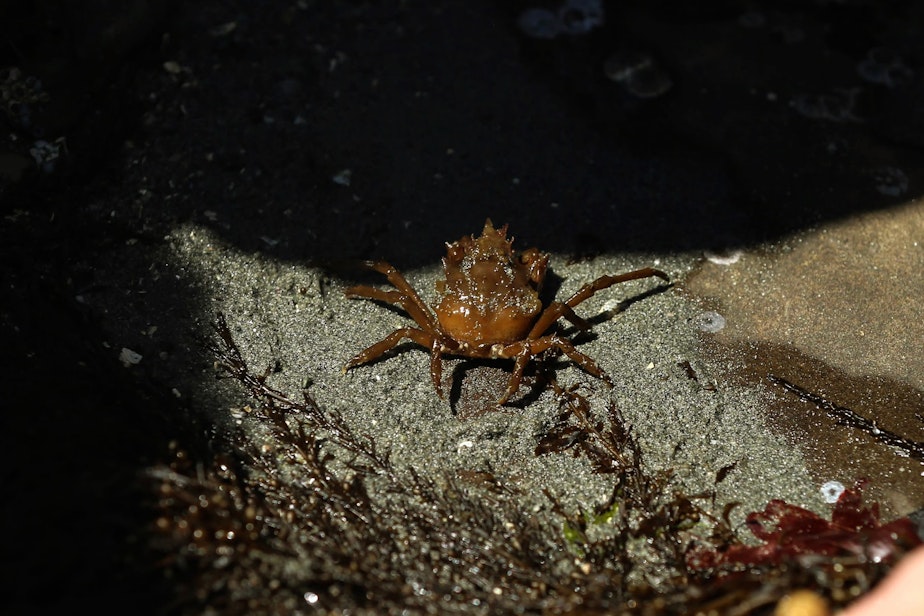It’s tidepool time! How you can explore Puget Sound’s shoreline during the lowest tides of the year

Seattle is in one of the best regions in the world for tidepooling, largely thanks to local, nutrient-rich water that feeds a bonanza of creatures.
“There are a few places around the world where the diversity and amount of sea life that you'll see in tide pools and the intertidal is just through the roof,” said John Meyer, former ecologist and co-author of “Between the Tides in Washington and Oregon.”
“We are fortunate enough to live in one of those places.”
The lowest tides in Seattle also fall during the day and — unlike our Californian neighbors — in the summer. Tuesday marked the lowest tide of the year so far, but the first weeks in July and August will also see super-low water levels that are ideal for finding sea creatures along our rocky shores.
Meyer shared his tips for tidepooling successfully — and responsibly — with “Seattle Now” host Patricia Murphy during an excursion in West Seattle.

Pick the right spot
The rocky, western shore of West Seattle is one of the best spots for tidepooling in the region.
“This particular spot … is one of the best that we’ve found [near Seattle],” Meyer said. Further out from the city, Deception Pass on Whidbey Island, the San Juan Islands and the shoreline along the Strait of Juan de Fuca are also abundant in tide pool life.
The intertidal area in West Seattle is home to a huge variety of animals and kelp, including many favorites like sea anemones and sea stars. Meyer explained that even within a small area, each beach will be home to different kinds of life.
“When you go around the top of Alki and you have that north facing beach, [it’s a] totally different environment. Totally different things living there. If you round the corner and you’re on the shoreline that faces Eliott Bay and downtown Seattle, again, totally different habitat, totally different animals.”

Wear the right gear
Before you venture onto the beach, though, be prepared: Wear sturdy, close-toed shoes. Meyer recommends rubber boots, the unofficial uniform of a marine ecologist, but sneakers will do just fine.
A hat that shades your face and plenty of sunscreen are also must-haves.
Head for the rocks
After you arrive at your tidepooling spot, look for places where small animals are taking refuge from the low tide.
“Any sort of hard surface is what you’re looking for,” Meyer explained, walking towards a set of boulders dotting the shore on Alki. “Those could be naturally occurring rocks like these ones. They could be rocks that have been placed because of, say, a jetty or something like that. Oftentimes, pier pilings can be a great place for species to latch onto.”
Rocks are anchor points for species like anemones, sea cucumbers and kelp, which aren’t mobile. They also provide safe harbor and shelter for scurrying species like crabs and sea stars.
Meyer said it pays to get on your hands and knees and look into the crevices under the rocks. At Alki, huge anemones, sea stars and bright orange sea cucumbers clung underneath some of those large boulders.

“Most of the animal is tucked way back under that rock in crevices, and it will extend when it’s feeling safe and like it’s time to feed,” Meyer said of sea cucumbers.
Get your hands dirty
The “look-but-don’t-touch” adage doesn’t apply to tidepooling, especially if you want to find more mobile critters that are hiding from predators and the elements.
“You want to minimize disturbance as best as you can, but it's OK to move some seaweed aside and see what's under it,” Meyer said. “It’s perfectly OK to move things aside, to gently turn over some of the smaller rocks and see what might be under there."
Meyer pulled aside a curtain of kelp on one rock to reveal a purple sea star, a kelp crab and coralline algae — a rough, pink algae named for its resemblance to coral.

It’s still important to leave things as you found them, though.
“A lot of animals depend on that seaweed so that they don't dry out, so put it back when you're done looking,” Meyer said. It’s also OK to gently touch creatures you come across. Meyer and Murphy took turns stroking the tentacles of a sea anemone with a finger — it gripped onto them, then tucked some tentacles inside to hide.
“It's OK to wet your hands and take a finger and see what these tentacles actually feel like,” Meyer said. “You can be curious, you can poke and prod a little bit. But I would keep that all to a minimum and just recognize that these animals are trying to make a living.”

Respect the sea
Even if you do some poking, prodding, and moving things around, be mindful to leave no trace on the environment you’re in. And importantly, watch where you step.
“It's incumbent on us to make sure that we're not stepping on these things that just simply can't get out of our way,” Meyer said. “There's a lot of bare spots in the intertidal. Try and set your feet there.”
Always make sure to return any rocks, plants or animals you disturb to the spot they were originally in — and of course, don’t leave anything you brought with you on the beach.
Listen to the full conversation with John Meyer by clicking the play button above, or searching for "Seattle Now" in any podcast app.
Editor's Note: This story has been updated to clarify that California also sees low tides during the day. The state does not often see super low tides in the summer months.





